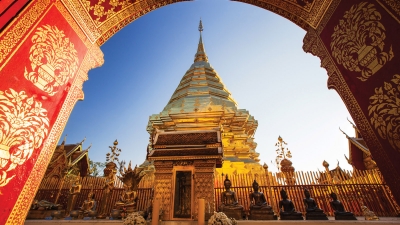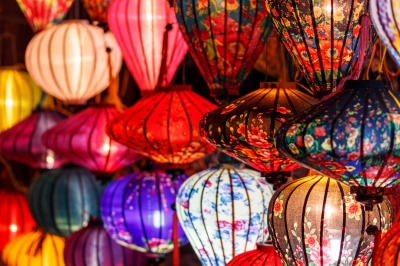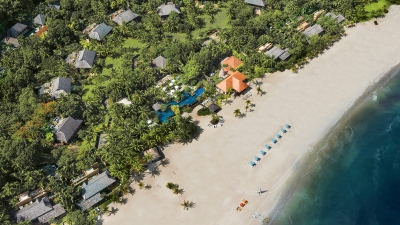Regarded as the cultural heartland of modern Thailand, Chiang Mai is a city of temples with an independent history and a rich heritage. Founded in 1296, Chiang Mai served for almost 500 years as the capital of the erstwhile Lanna Kingdom - a proud and independent entity in the north of Thailand. Eventually absorbed into the repatriated Thai State of Thonburi, following the fall of Ayutthaya in the south, Chiang Mai represents a fascinating window into the past. Glistening chedis and barefoot monks are transcribed by a more modern metropolis today, but ancient customs and beautiful ornate temples are still the biggest draw here. “Chiang Mai is a beautiful and vibrant city with many natural, historic, and cultural attractions,” shares Ashok Nair, Director of Rooms and Residences at Four Seasons Resort Chiang Mai. “We’ve shortlisted our top must-visit temples and sites to earmark for your next holiday.”
Wat Phra That Doi Suthep
Pre-eminent among the many prestigious temples of Chiang Mai, Wat Phra That is situated high up on Doi Suthep, a mountain that rises steeply to the west of the city. “Legend states that a Buddha relic (specifically a portion of his shoulder blade) was brought up to this site by a white elephant from the stable of King Nu Naone of Lanna,” shares Ashok. The original gold-plated chedi towers 24 metres (79 feet) above the courtyard with a redented octagonal base, typical of northern Thai temples. “The magnificent vistas of Chiang Mai below are another reason to visit this very significant temple,” he adds.
Wat Chedi Luang
Once home to the legendary Emerald Buddha, Wat Chedi Luang dates all the way back to the mid-fifteenth century and played a significant role in Lanna history. When completed, it rose a staggering 84 metres (275 feet) above the city centre, the tallest construction, by far, in medieval northern Thailand. Damaged by an earthquake in 1545, the temple was restored only much later in the 1990s but displays a duality of original and modern reconstruction that give it a distinct profile.
Wat Umong Chiang Mai
Built in 1297 by King Magrai of Lanna amid the jungles below Doi Suthep, Wat Umong is unique for its tranquil setting and ornate interior tunnels. “Famous also for its monks who live close to nature, feeding the resident deer and birds by hand, this is a fascinating insight into the monastic traditions of Chiang Mai’s Lanna past,” shares Ashok.
Wat Jed Yod
Just a little northwest of the city centre, the seven spires of Wat Jet Yod represent a departure from Thai styled temple architecture. Built to reflect the Mahabodhi Temple in Bagan, Myanmar (itself a representation of the original Mahabodhi Temple in Bodh Gaya, India), the temple was commissioned by King Tilokarat of Lanna in 1455 and displays many Indian design elements such as the pyramidic spires. “The exterior of the rectangular base features exquisite stucco reliefs (even if weathered) of Thewadas (divine beings), allegedly modelled after relatives of King Tilokarat,” Ashok says.
Wat Phraphutthabat Si Roi
Located amid the remote rice fields in the north of Chiang Mai, a visit to Wat Phraphutthabat Si Roi (Temple of the Four Buddha Footprints) includes journeying through the small villages of northern Thailand into an idyllic farm scenery. Built around an enormous footprint believed to be of the Buddha himself, this temple is exquisitely ornate.
Chiang Mai City Walls and Gates
As seat of the ruler of the erstwhile Kingdom of Lanna, Chiang Mai was fortified with a defensive wall and moat that surrounded the core of the city during its glory days. Built as a square, the fort walls each had a gate corresponding to the cardinal directions of north, south, east and west. “Today, only portions of the Thapae Gate facing east and the Chiang Mai Gate towards the south remain to suggest what this vaunted city-fort once looked like,” shared Ashok. Partially restored and still central to any of the city's festivities, these gates and the beautifully curated gardens around them are a majestic site for any visitor.
The Three Kings Monument
In the heart of the old-walled city, the Three Kings Monument was built as a tribute to the three most significant Thai rulers during the early years of the Lanna Kingdom, including Phaya Mengrai, the city’s founder along with Phaya Ramkhamhaeng of Sukhothai, and Phaya Ngam Muang of Phayao. Designed and constructed by a renowned Thai artist in 1983, this elegant monument and the large courtyard in front of it are considered to be the symbolic centre of the modern city.
Wiang Kum Kam
King Mengrai’s first attempt at a settlement along the Mae Ping river, Wiang Kum Kam gives us a glimpse into the early Lanna period, when the Tai Yuan displaced the earlier Mon people of Hariphunchai. Guests can visit the 13th century ruins of Wat I Kham and Wat Nan Chang, as well as the magnificent Mon-style Wat Chedi Liam. “This five-tiered chedi has been recently restored to full glory,” adds Ashok.
Wat Chiang Man
Perhaps the most significant construction during the reign of King Mengrai, Wat Chiang Man (1297 CE) was built to serve as the first temple of the young city of Chiang Mai. Distinctly Lanna in its styling, the temple’s majestic elephant chedi is a sight to behold.
Some within close proximity of Four Seasons Resort Chiang Mai, the Resort’s expert concierge team helps curate special tours to these notable attractions for guests. “Chiang Mai is fascinating,” smiles Ashok, “A melting pot of culture, tradition and modernity – waiting to be discovered.”














